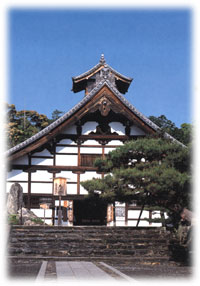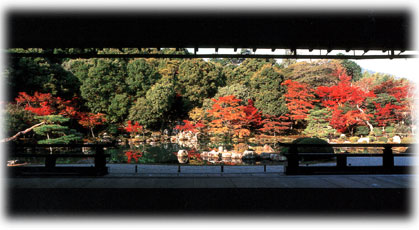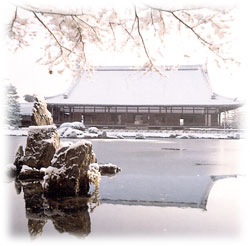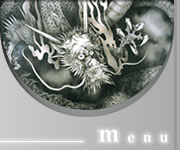
Tenryu-ji, located in the Sagano district in the western outskirts of Kyoto,
is the head temple of the Tenryu-ji branch of Rinzai Zen Buddhism. It was
established in 1339 by the shogun Ashikaga Takauji 足利尊氏 (1305–58) in memory
of Emperor Go-Daigo 後醍醐 (1288–1339), who died in the mountains of Yoshino
following the civil war that brought the Ashikaga family to power. The
eminent Zen master Muso Soseki 夢窓疎石 (1275–1351) was appointed the temple’s
founding abbot.
The site of Tenryu-ji
had earlier been occupied by the temple Danrin-ji 檀林寺, established in the
ninth century and historically significant as the first Zen temple in Japan.
In the thirtheenth century Emperor Kameyama 龜山 (1249–1305) built a villa on
the property, and it was here that Go-Daigo, his grandson, was raised and
educated. With Go-Daigo’s passing in 1339 the villa’s conversion to a Zen
temple was ordered by Ashikaga. The temple received the name Tenryu-ji,
“Temple of the Heavenly Dragon,” because after Emperor Go-Daigo’s death a
priest friend of his dreamed of a dragon rising from the river just south of
the temple.
 In order to finance
the temple’s construction, Takauji’s younger brother Tadayoshi 直義
(1306–1352) and Muso Soseki commissioned a vessel, known as the “Tenryu-ji
Ship,” on a trade mission to Yuan-dynasty China. In 1342 the new temple was
designated number two of the Kyoto Five Mountain monasteries. By 1345 the
major buildings of the temple were complete, and the temple was opened in a
great ceremony combined with a memorial service for Emperor Go-Daigo. A year
later Soseki constructed a Sodo (Monk’s Hall) capable of accommodating a
thousand monks.
In order to finance
the temple’s construction, Takauji’s younger brother Tadayoshi 直義
(1306–1352) and Muso Soseki commissioned a vessel, known as the “Tenryu-ji
Ship,” on a trade mission to Yuan-dynasty China. In 1342 the new temple was
designated number two of the Kyoto Five Mountain monasteries. By 1345 the
major buildings of the temple were complete, and the temple was opened in a
great ceremony combined with a memorial service for Emperor Go-Daigo. A year
later Soseki constructed a Sodo (Monk’s Hall) capable of accommodating a
thousand monks.
Although Tenryu-ji
was at first designated number two in the Five Mountains system, in 1386 it
was accorded the top position, only to lose it in 1401 to Shokoku-ji. In
1410, however, it recovered its number one ranking and has remained in that
position ever since.
Soseki’s lineage prospered, and came to play a leading role in the
flourishing Zen literary culture known as gozan bungaku 五山文學.
 In the centuries
since its founding Tenryu-ji has been ravaged by fires a total of eight
times, first in 1358 and again in 1367; on both occasions the Zen master Shun’oku Myoha 春屋明葩 (1311–1388), Muso Soseki’s disciple, helped restore the
temple. Fires occurred again in 1373, 1380, 1447, and 1468 (when it was
torched during the Onin Wars). Some reconstruction occurred, but it was not
until after 1585, when Toyotomi Hideyoshi 豐臣秀吉 (1536-1598) lent his support
to the temple, that full scale restorative works could begin. Further fires
occurred in 1815 and 1864 (when Tenryu-ji was again torched during
disturbances surrounding the end of the Tokugawa shogunate). Most of the
present buildings thus date only to the Meiji period (1868–1912). However,
the landscape garden behind the Hojo (Main Hall) is one of the oldest in
Japan, retaining the same form as when it was designed by Muso Soseki in the
fourteenth century. Known as the Sogenchi 曹源池 Garden, it was the first
Special Historical Scenic Area named by the Japanese government, and in 1994
it was designated by the United Nations as a World Cultural Heritage site.
In the centuries
since its founding Tenryu-ji has been ravaged by fires a total of eight
times, first in 1358 and again in 1367; on both occasions the Zen master Shun’oku Myoha 春屋明葩 (1311–1388), Muso Soseki’s disciple, helped restore the
temple. Fires occurred again in 1373, 1380, 1447, and 1468 (when it was
torched during the Onin Wars). Some reconstruction occurred, but it was not
until after 1585, when Toyotomi Hideyoshi 豐臣秀吉 (1536-1598) lent his support
to the temple, that full scale restorative works could begin. Further fires
occurred in 1815 and 1864 (when Tenryu-ji was again torched during
disturbances surrounding the end of the Tokugawa shogunate). Most of the
present buildings thus date only to the Meiji period (1868–1912). However,
the landscape garden behind the Hojo (Main Hall) is one of the oldest in
Japan, retaining the same form as when it was designed by Muso Soseki in the
fourteenth century. Known as the Sogenchi 曹源池 Garden, it was the first
Special Historical Scenic Area named by the Japanese government, and in 1994
it was designated by the United Nations as a World Cultural Heritage site.


 Tenryu-ji, located in the Sagano district in the western outskirts of Kyoto,
is the head temple of the Tenryu-ji branch of Rinzai Zen Buddhism. It was
established in 1339 by the shogun Ashikaga Takauji 足利尊氏 (1305–58) in memory
of Emperor Go-Daigo 後醍醐 (1288–1339), who died in the mountains of Yoshino
following the civil war that brought the Ashikaga family to power. The
eminent Zen master Muso Soseki 夢窓疎石 (1275–1351) was appointed the temple’s
founding abbot.
Tenryu-ji, located in the Sagano district in the western outskirts of Kyoto,
is the head temple of the Tenryu-ji branch of Rinzai Zen Buddhism. It was
established in 1339 by the shogun Ashikaga Takauji 足利尊氏 (1305–58) in memory
of Emperor Go-Daigo 後醍醐 (1288–1339), who died in the mountains of Yoshino
following the civil war that brought the Ashikaga family to power. The
eminent Zen master Muso Soseki 夢窓疎石 (1275–1351) was appointed the temple’s
founding abbot.

 In order to finance
the temple’s construction, Takauji’s younger brother Tadayoshi 直義
(1306–1352) and Muso Soseki commissioned a vessel, known as the “Tenryu-ji
Ship,” on a trade mission to Yuan-dynasty China. In 1342 the new temple was
designated number two of the Kyoto Five Mountain monasteries. By 1345 the
major buildings of the temple were complete, and the temple was opened in a
great ceremony combined with a memorial service for Emperor Go-Daigo. A year
later Soseki constructed a Sodo (Monk’s Hall) capable of accommodating a
thousand monks.
In order to finance
the temple’s construction, Takauji’s younger brother Tadayoshi 直義
(1306–1352) and Muso Soseki commissioned a vessel, known as the “Tenryu-ji
Ship,” on a trade mission to Yuan-dynasty China. In 1342 the new temple was
designated number two of the Kyoto Five Mountain monasteries. By 1345 the
major buildings of the temple were complete, and the temple was opened in a
great ceremony combined with a memorial service for Emperor Go-Daigo. A year
later Soseki constructed a Sodo (Monk’s Hall) capable of accommodating a
thousand monks.
 In the centuries
since its founding Tenryu-ji has been ravaged by fires a total of eight
times, first in 1358 and again in 1367; on both occasions the Zen master Shun’oku Myoha 春屋明葩 (1311–1388), Muso Soseki’s disciple, helped restore the
temple. Fires occurred again in 1373, 1380, 1447, and 1468 (when it was
torched during the Onin Wars). Some reconstruction occurred, but it was not
until after 1585, when Toyotomi Hideyoshi 豐臣秀吉 (1536-1598) lent his support
to the temple, that full scale restorative works could begin. Further fires
occurred in 1815 and 1864 (when Tenryu-ji was again torched during
disturbances surrounding the end of the Tokugawa shogunate). Most of the
present buildings thus date only to the Meiji period (1868–1912). However,
the landscape garden behind the Hojo (Main Hall) is one of the oldest in
Japan, retaining the same form as when it was designed by Muso Soseki in the
fourteenth century. Known as the Sogenchi 曹源池 Garden, it was the first
Special Historical Scenic Area named by the Japanese government, and in 1994
it was designated by the United Nations as a World Cultural Heritage site.
In the centuries
since its founding Tenryu-ji has been ravaged by fires a total of eight
times, first in 1358 and again in 1367; on both occasions the Zen master Shun’oku Myoha 春屋明葩 (1311–1388), Muso Soseki’s disciple, helped restore the
temple. Fires occurred again in 1373, 1380, 1447, and 1468 (when it was
torched during the Onin Wars). Some reconstruction occurred, but it was not
until after 1585, when Toyotomi Hideyoshi 豐臣秀吉 (1536-1598) lent his support
to the temple, that full scale restorative works could begin. Further fires
occurred in 1815 and 1864 (when Tenryu-ji was again torched during
disturbances surrounding the end of the Tokugawa shogunate). Most of the
present buildings thus date only to the Meiji period (1868–1912). However,
the landscape garden behind the Hojo (Main Hall) is one of the oldest in
Japan, retaining the same form as when it was designed by Muso Soseki in the
fourteenth century. Known as the Sogenchi 曹源池 Garden, it was the first
Special Historical Scenic Area named by the Japanese government, and in 1994
it was designated by the United Nations as a World Cultural Heritage site.